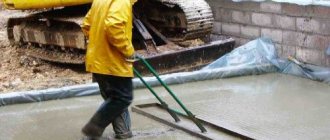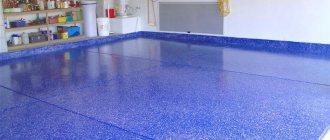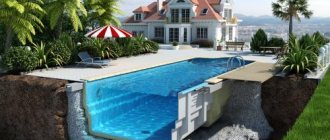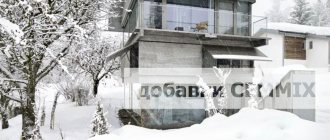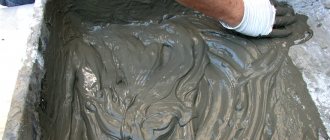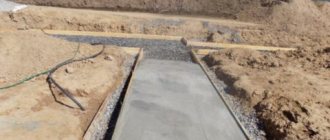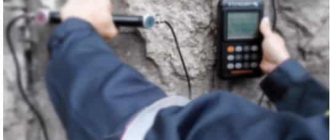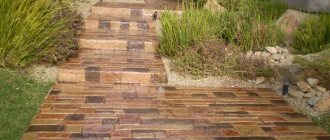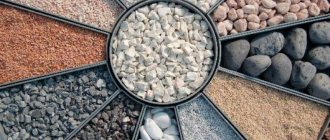X
My friend, would you like polished concrete in your rooms? Immediately, in words - a concrete floor - a sophisticated reader will immediately say: Phew! Gray, concrete floor, even if it had been polished three times. What could be more boring? Don't rush to fool around.
A properly polished (and not three times at all) concrete floor looks very similar to granite or marble. Noble stone. Moreover, this is an excellent alternative for those who are tired of linoleum and parquet. Imagine: a surface like a mirror and with perfect shine and this is your future floor.
The most important thing is that you can make this beauty with your own hands. We will tell you in detail how to polish concrete in this article.
Helpful information:
- How to build an attic with your own hands
- How to make a self-leveling floor with your own hands
- How to insulate the floor in a bathhouse with your own hands
- Do-it-yourself wall chipping
- Do-it-yourself septic tank from Eurocubes
- Mobile camp sauna - do it yourself
All floor polishing operations are not abstruse and do not require special skills. True, you will need special grinding tools and hardeners. Look, the Americans and Europeans are coping with this, but we can’t cope? It turns out that 70% of all concrete floors taken from foreigners are made using this technology. And we are a distrustful people. We divide, as in Stanislavsky, into “I believe” and “I don’t believe.” In Mother Russia, while some are taking a closer look and getting used to it, others are already making these beautiful and practical floors for themselves.
Why is concrete polishing necessary?
Polishing concrete is done not only for beauty and the envy of neighbors. Fashionable technology will complement it with new qualities:
- Strength and wear resistance are significantly increased;
- The service life is 3-4 times higher than that of unsanded floors;
- After all, as Elena Malysheva would say, it’s hygienic!
Polishing is applied in varying degrees - from shimmering matte to shiny glossy. Whoever likes it. You don’t have to worry about scratching the coating and repairing it will also be easy. It is not without reason that polished concrete can be seen in places where there is a dense flow of people:
- Foyers, corridors of hospitals and educational institutions;
- Offices, business centers;
- Shopping centers and exhibition halls;
- Cafes, restaurants, hotel lounges;
- Train stations and airports.
Cement brand M500: how to choose and characteristics
Polished concrete can reduce noise and dampen vibration. It is highly durable. These properties were appreciated in car parks, workshops and warehouses.
Very convenient for cleaning. This turned out to be an obvious advantage for food industry enterprises, medical institutions, and kindergartens.
Polished concrete is resistant to moisture and chemical influences. This made it possible to use it in greenhouses and swimming pools. In general, wherever the environment for building materials is aggressive.
A polished floor is a modern style and newfangled chic. It will perfectly complement the interior in high-tech and loft style. It will look great among all sorts of designer items.
Methods of polishing concrete
The polishing process is quite complex. It happens that a tool is used that the home craftsman often does not have. Therefore, it is easier to contact specialists or rent. As for the technological process, there are two options for different types of polishing:
- Cross processing method. Here a machine is used that moves chaotically across the floor and gives it a glossy shine. The machines are complex and require the use of expensive polishing discs, but they are effective because, in addition to concrete, they are even capable of polishing natural stone. The method is also called: “ Polishing concrete by helicopter ”
- Planetary processing method. The method is similar to the previous one, but here the movement of the disk is fundamentally different, they rotate towards each other. This treatment is considered rougher, but at the same time, suitable for complex surfaces that include crushed stone. That is, with the help of such a system it is possible to rub and polish floors not only from semi-dry screed, but also from screed with crushed stone.
While working, you may find that there are places on the floor with limited access. These may be places in the corners of the room, as well as curvature of the geometry of the room, which is caused by design issues. To do the job perfectly, there should be no missing places.
Therefore, craftsmen use a trick and in those places where using a large machine is impossible, they put a grinding disc on an ordinary grinder. Polishing with a grinder involves choosing a tool with an individual disc diameter, as well as the ability to adjust the speed.
Do not confuse two concepts such as grinding and polishing. Sanding is the first stage, which only prepares the floors for further polishing. Polishing allows you to achieve an ideal result, hides irregularities, removes scratches, makes the surface smooth and sometimes it seems that it has been treated with modern compounds, such as wax. A mirror effect is often achieved by using self-leveling flooring compounds, which also require polishing. This applies to epoxy.
Benefits of polished concrete
Abroad will help us in terms of transferring 35 years of experience in using polished floors. These are the benefits that concrete has after processing.
- Wear resistance only increases over time. It is only necessary to repeat the polishing with the application of impregnation after 5-7 years.
- Maintenance becomes much easier.
- Strength increases by 2-3 times. Resistance to chemicals and abrasion by 54%.
- The coating can be renewed and repairs are not difficult.
- The surface is very decorative, similar to a noble stone.
- Surprisingly, vapor permeability does not decrease. Floors breathe and this is important for the microclimate of the room.
- Does not emit harmful substances (resins, solvents, etc.).
Polished concrete technology
Polished concrete is an alternative coating option that imitates cladding made of noble natural stones - granite, marble, travertine, slate. A perfectly smooth surface with a mirror-like shine can be achieved with simple operations using hardening compounds and grinding with special tools.
Concrete polishing is widespread in Europe and America. About 70% of all floors in public buildings and industrial facilities are made using this technology. In Russia, their share is small, although the popularity of practical and beautiful coatings is growing every year.
Manufacturing technology
The entire concrete polishing chain consists of several links:
- Concrete compression testing;
- Stage 1 of grinding – sealing cracks, general leveling;
- Dust removal;
- Impregnation with special compounds;
- Sealing pores, chips and minor defects with cement;
- Stage 2 of sanding on the wet floor;
- Stage 3 of polishing with grinding devices to the desired degree of gloss;
- If desired, at this stage you can paint the floor with a colored hardener;
- Final polishing and treatment with anti-slip compounds.
The new floor can be polished one day after concreting. If you decide to grind an old concrete floor, for God’s sake, at any time.
Impregnations are called impregnations because they penetrate deeply. Penetrating into concrete, they change its structure, clog pores, increase moisture resistance, and eliminate dust from the surface.
Lithium silicates are all the rage these days. It is on their basis that impregnations are made. Well, for example, the Italian brand of sealer Stain Protection. Do you feel the smell of Rome and pizza? Russian brands LITSIL and Ultralit are also not lagging behind, selling their products throughout the country.
Concrete grades and their use in construction
With impregnations it’s clear. Let's find out what to grind concrete floors with, what equipment? For home squaring, an angle grinder will suffice, but the quality of polishing will be somewhat worse. For large areas, special grinding machines are used. Their result is not to find fault.
How to polish concrete
To obtain a smooth, shiny coating horizon, the treatment is carried out using special equipment and has several stages. What kind of equipment is this:
- Coatings that have expired and large irregularities are removed with traverse milling and grinding machines;
- Polished to a high shine using planetary grinders;
- To get into difficult places, use an angle grinder. Where would my dear be without her?
Dust is removed with industrial vacuum cleaners. When grinding, discs, pads, cups or Frankfurts are used. The abrasive grain size of these miracle skins is 50-3000 grit.
The first treatment is performed with diamond-coated abrasive. Grit size from 50 to 120 grit. Basic processing up to 200 grit. When polishing, the grit is increased step by step: 400 -> 3000 grit -> BUFF. The result of these measures is a semi-matte, glossy or matte surface.
How to polish concrete
Polishing the concrete surface is the finishing touch. And the first question that arises is - how to polish concrete? There is special polishing equipment. These machines are compact in size, so they can be used in rooms of any size. There are two types:
- Cross, in which the working circles are located on a stationary plane and move in opposite directions during operation. These machines are designed for grinding and polishing concrete only and are not suitable for natural stone.
- Planetary. The design of these machines provides for the installation of working disks on a rotating base. The circles and the base move towards each other. This technique copes well with both concrete and stone surfaces. Therefore, to create a mirror floor, you need to use a planetary machine, since polishing concrete with high-strength crushed stone aggregate is more difficult than usual.
Tips for polishing concrete
The quality of the coating depends on compliance with the main condition - the compressive strength of concrete. If this property is less than 20 MPa, then the polishing will not achieve the desired effect. To determine strength, there is a device with the terrible name sclerometer.
Moreover, the concrete mixture should consist of 85% coarse backfill. An excellent effect is obtained if the solution is made with granite, diorite or marble chips. Limestone is absolutely not suitable - it is weak for this purpose.
The best way is to take and mix different sizes of backfill. Make sure that the largest pieces of crushed stone do not exceed 20 mm.
Then this whole economy is mixed. Plasticizers are added to increase density. Concrete is laid on the prepared base in a layer no thinner than 50 mm. Allow to harden and begin processing.
Features of polished concrete
Some compare polished floors with bases that are coated with special polymer compounds. However, it is worth saying that when choosing between these types of processing, preference should be given to polishing. The fact is that in the case of creating a polymer protective layer, the surface does not breathe, which in turn leads to the retention of water vapor. If we talk about polished concrete, then in this case the base will be freed from excess moisture, due to which the pH level in the room increases. In addition, no migrating chemicals, harmful bacteria, mold or fungi are formed on polished surfaces.
Also, it is worth paying attention to other advantages of polished and honed concrete floors:
- increased hardness and strength of the resulting surface;
- externally, polished concrete resembles marble, but is superior to it in impact resistance;
- the top layer of polished concrete, unlike polymer, is connected to the base to form a single monolith;
- thanks to polishing, the risk of abrasion is reduced;
In addition, polished concrete is resistant to chemical influences and can be easily repaired.
Coverings of this type are most often installed in warehouses, industrial areas, shopping centers, administrative and residential buildings.
At the same time, grinding and polishing can be done at home, provided that the cement-sand floor screed is properly prepared.
Step-by-step execution of work
Let's remember the steps that polishing a concrete floor includes:
- The entire surface is cleaned, protruding reinforcement is removed, all cracks are sealed with epoxy;
- Next, grinding with a tool with a grain of 30 -> 50 -> 120 grit. After each operation, dust is removed;
- A strengthening compound is sprayed onto the surface. Consumption, which is 100-300 ml/m². The reinforcement should lie evenly. To do this, rub it with a soft brush;
- Pores, holes and other misfortunes are clogged with cement mortar. Sprinkle a thin layer of astringent on top, mixing with the strengthener to form a thick paste. The product is consumed at the rate of 400-900 g/m².
- At this stage, they do not wait for the mass to harden, but grind it immediately. Spraying with 200 grit grain is used. They wipe off the dust and look. If irregularities of more than 5 mm remain, then grinding is done again after 12 hours;
- Floor polishing is a step-by-step process, using abrasive grains from 400 grit. The shine of the mirror is obtained using plastic pads or discs with grain up to 3000 grit. Below is a table of abrasive discs.
How to make concrete flowerpots that the whole family will love
For absolute beauty and silky gloss, apply a strengthener in 2-3 layers and allow to dry. After this, they begin to polish the floor with felt with their own hands. And here it is - beauty! The old concrete surface is also brought back to life.
